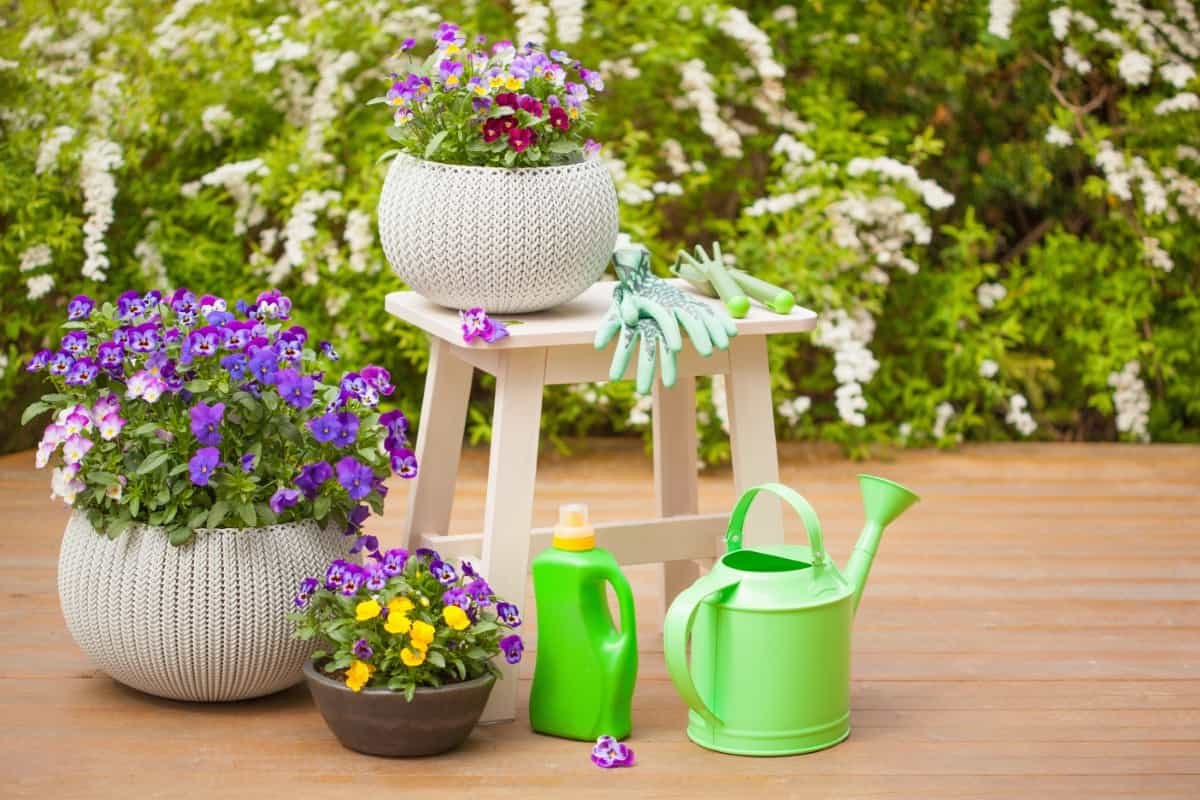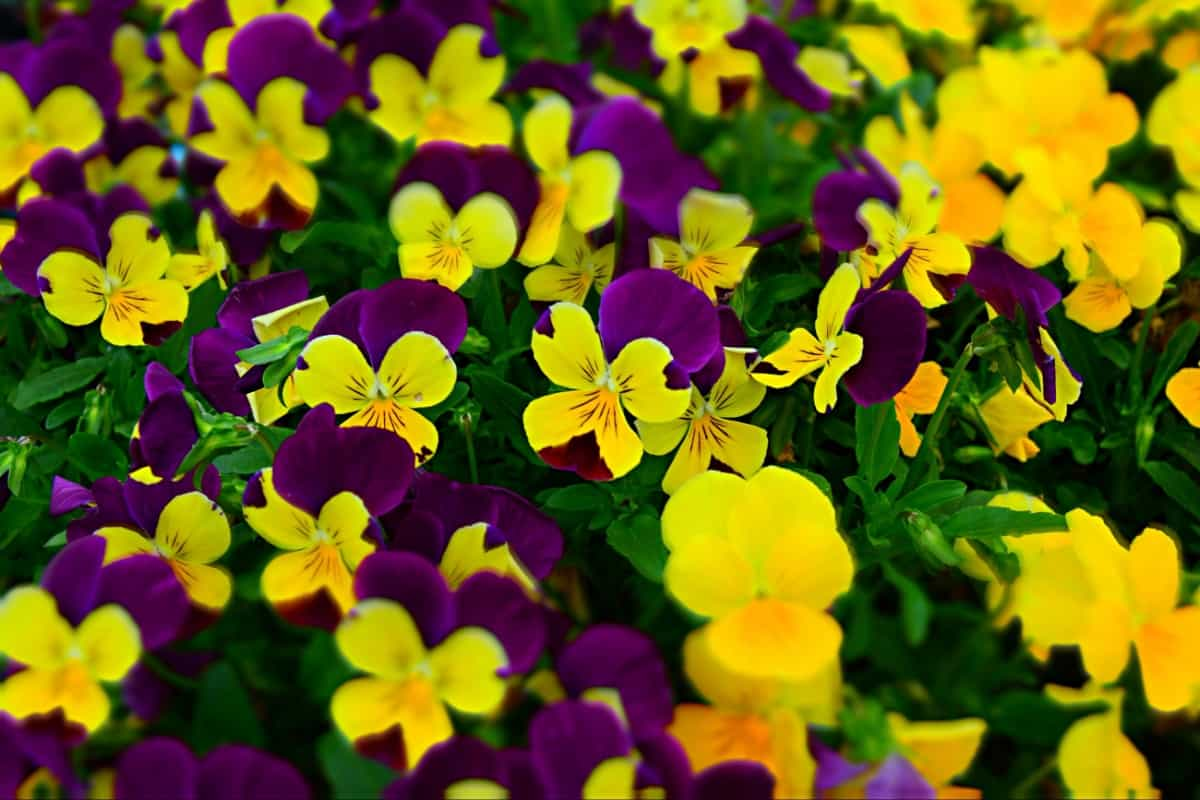The pansy, a charming flowering plant beloved for its bright and bold colors, requires meticulous care to ensure it thrives and blossoms to its full potential. One critical aspect of this care is the appropriate use of fertilizer. The perfect pansy fertilizer can be organic, synthetic, or even homemade, depending on the gardener’s preference and the plant’s specific needs. Understanding the pansy’s fertilization requirements is important to ensure the plant’s health and vibrancy.

Best Fertilizer for Pansies
Choosing Between Organic and Synthetic Fertilizers
When choosing a fertilizer for pansies, gardeners often choose between organic and synthetic options. Organic fertilizers from compost, manure, or bone meal deliver nutrients slowly. These organic options benefit the soil’s long-term health, improving its structure and promoting the growth of beneficial microorganisms. On the other hand, synthetic fertilizers offer a more concentrated, immediate source of nutrients.
These fertilizers are chemically formulated to provide the precise NPK ratios (Nitrogen, Phosphorus, and Potassium) that plants need to grow. A balanced NPK ratio, such as 10-10-10, is typically recommended for pansies. However, if the soil testing shows a deficiency in a specific nutrient, a different NPK ratio may be used to compensate. For instance, a fertilizer with a higher phosphorus content could help stimulate bloom production if the soil is deficient in this nutrient.
Homemade Fertilizer Solutions
For those interested in sustainable gardening, homemade fertilizers can be an excellent choice for pansies. Homemade fertilizers can be made from common household waste, such as eggshells, coffee grounds, or banana peels. For example, eggshells can provide a source of calcium, which is essential for plant cell growth.
Coffee grounds offer nitrogen, and banana peels are high in potassium. These homemade solutions can be mixed into the soil or compost pile as a natural, organic fertilizer. However, the gardener must ensure that the homemade compost is well-rotted before using it, as fresh organic matter can steal nitrogen from the soil as it decomposes, harming the pansies.
Winter Pansy Requirements
These hardy little plants need some extra attention when it comes to winter pansy requirements. They can withstand the cold, but their nutrient needs change as the temperatures drop. In the cooler months, pansies need less nitrogen and more potassium. Too much nitrogen in the winter can cause the plants to produce lush foliage at the expense of blooms, making them more susceptible to cold damage.
In case you missed it: The Best Fertilizer for Peonies: When and How to Apply

On the other hand, potassium helps improve the plant’s overall hardiness, helping it withstand the harsh winter conditions. So, a fertilizer with a lower first number (N) and a higher last number (K) in the NPK ratio would be more suitable for winter pansies.
Timing and Method of Fertilizer Application
The timing and fertilizer application method can significantly influence pansies’ health and blooming. Pansies should be fertilized at planting time and then regularly throughout the growing season. A slow-release fertilizer applied at planting time can provide nutrients for several months, while liquid or granular fertilizers can be applied every 4-6 weeks.
When applying fertilizer, it is essential to follow the package instructions to avoid over-fertilization, which can harm the plants. To prevent burning the pansies, apply fertilizer to the soil surrounding them. If using a liquid fertilizer, it can be helpful to water the plants first to ensure the fertilizer is well-drained.
Understanding the Fertilization Requirements of Pansies
Understanding the fertilization requirements of pansies is an ongoing process. It requires frequent soil testing to assess the soil’s nutrient levels and adjust the fertilization regimen. Soil testing kits are readily available and relatively easy to use. Regular testing helps identify nutrient deficiencies or excesses in the soil that could impact the pansies’ health and blooming.
Fertilizing Pansies in Different Growth Stages
The fertilization needs of pansies can also vary depending on the plant’s growth stage. For instance, young pansy plants need a higher nitrogen level to promote vigorous foliage growth. Phosphorus is essential for flowering as the plant grows. Therefore, the gardener might need to switch between different fertilizers or adjust the NPK ratios at different plant growth stages.
The Role of pH in Pansy Fertilization
The pH of the soil also plays a crucial role in pansy fertilization. Pansies prefer slightly acidic soil with a pH between 5.5 and 6.2. If the soil’s pH is outside this range, it can hinder the plant’s ability to absorb the nutrients from the fertilizer, regardless of how much fertilizer is applied. Therefore, regular pH testing and adjustment, using lime to raise the pH or sulfur to lower it, is another essential aspect of pansy care.
Choosing the Best Fertilizer for Pansies
The best pansy fertilizer depends on the plant’s demands, soil conditions, the gardener’s preferences, and the season. The gardener might combine organic and synthetic fertilizers or switch between different types and NPK ratios of fertilizers at different times of the year. The use of homemade compost can also be an excellent supplement to the fertilizer regimen, adding a broad spectrum of nutrients and improving the soil structure. However, the gardener should be aware of the specific nutrient contents of these homemade fertilizers and how they fit into the overall fertilization plan.
The Importance of Proper Fertilizer Dosage
Ensuring the correct dosage of fertilizer for your pansies is crucial. Over-fertilization can lead to nutrient toxicity, damaging plant roots and hindering nutrient uptake. This condition often manifests as burnt leaf tips, wilting, or stunted growth. In contrast, under-fertilization can lead to nutrient deficiencies, compromising the plant’s overall health and vibrancy. Providing enough nutrients to ensure healthy, strong development without overloading the plant is the key.
In case you missed it: The Best Fertilizer for Gerbera Daisy: When and How to Apply

When determining the appropriate dosage, following the manufacturer’s instructions on the fertilizer packaging is important. These guidelines are designed to provide optimal nutrient levels for most plants, including pansies. However, it’s also crucial to consider your plants’ specific needs and the soil’s current condition. Regular soil tests can provide invaluable information on the soil’s nutrient levels and help you adjust your fertilization regimen accordingly.
Conclusion
Fertilizing pansies is not merely a matter of choosing and applying the right product. It balances factors, including understanding the plant’s needs, assessing and adjusting the soil conditions, and choosing the appropriate fertilizer type. Proper fertilization and other care practices, such as regular watering, adequate sunlight, and pest control, can help ensure that pansies remain vibrant and healthy throughout the growing season and beyond.
- Ultimate Guide to Ossabaw Island Hog: Breeding, Raising, Diet, and Care
- Ultimate Guide to Juliana Pig: Raising Facts, Size, Diet, Care, and Lifespan
- Raising Lleyn Sheep: Disadvantages, Price, Uses, Characteristics, and Care
- Ultimate Guide to Meishan Pig: Breed Facts, Breeding, Raising, and Care
- Ultimate Guide to Teacup Pigs: Raising, Diet, Lifespan, Cost, and Care
- Guide to Raising Poll Dorset Sheep: Facts, Profile, Characteristics, Uses, and Care
- Ultimate Guide to Bighorn Sheep: Characteristics, Diet, Lifespan, Breeding, and Lifecycle
- Ultimate Guide to Raising Katahdin Sheep: Farming Facts, Breed Profile, Uses, and Care
- Ultimate Guide to Raising Oreo Cows: Belted Galloways Farming Facts, Profile, Uses, and Care
A couple of days ago, I visited my mom’s and noticed that her new flowers look like they’re about to die. I think she’d consider adding fertilizer to them, so I’ll suggest it when I see her. I appreciate your advice about using the correct amount of fertilizer for our pansies to avoid damaging their roots.